Page 128 of 216
HAZARD WARNING FLASHER
The flasher switch is on top of the steering column,
just behind the steering wheel. Depress the switch
and both cluster indicators and all front and rear direc-
tional signals will flash. Depress the switch again to turn
Hazard Warning Flashers off.Do not use this emergency warning system when the
vehicle is in motion. Use it when your vehicle is disabled
and is creating a safety hazard for other motorists.
If it is necessary to leave the vehicle to go for service, the
flasher system will continue to operate with the ignition
key removed and the vehicle locked.
NOTE:With extended use, the flasher may wear down
your battery.
IF YOUR ENGINE OVERHEATS
In any of the following situations, you can reduce the
potential for overheating by taking the appropriate ac-
tion.
•On the highways—Slow down.
•In city traffic—While stopped, put transaxle in
neutral, but do not increase engine idle speed.
Hazard Flasher Switch
128 WHAT TO DO IN EMERGENCIES
Page 137 of 216
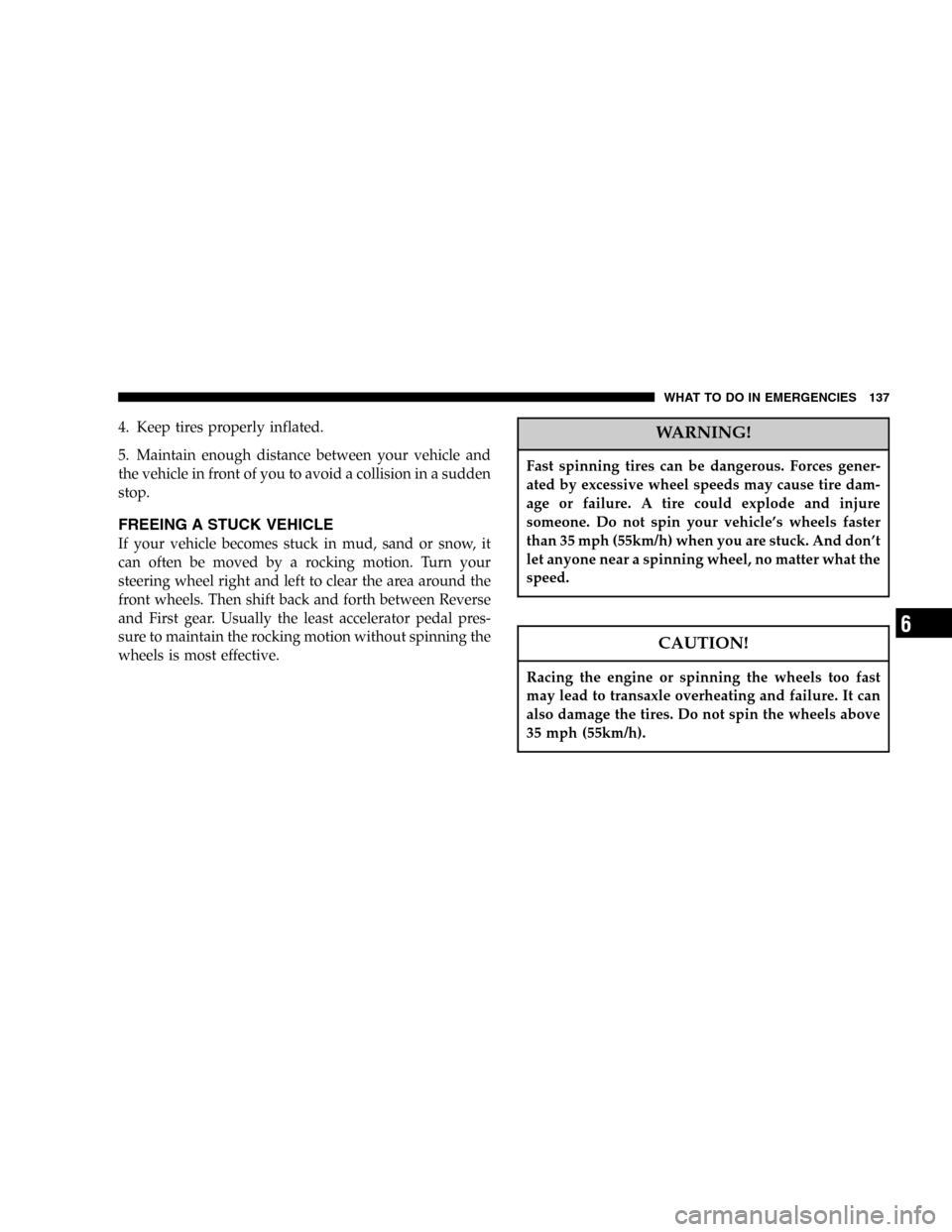
4. Keep tires properly inflated.
5. Maintain enough distance between your vehicle and
the vehicle in front of you to avoid a collision in a sudden
stop.
FREEING A STUCK VEHICLE
If your vehicle becomes stuck in mud, sand or snow, it
can often be moved by a rocking motion. Turn your
steering wheel right and left to clear the area around the
front wheels. Then shift back and forth between Reverse
and First gear. Usually the least accelerator pedal pres-
sure to maintain the rocking motion without spinning the
wheels is most effective.
WARNING!
Fast spinning tires can be dangerous. Forces gener-
ated by excessive wheel speeds may cause tire dam-
age or failure. A tire could explode and injure
someone. Do not spin your vehicle’s wheels faster
than 35 mph (55km/h) when you are stuck. And don’t
let anyone near a spinning wheel, no matter what the
speed.
CAUTION!
Racing the engine or spinning the wheels too fast
may lead to transaxle overheating and failure. It can
also damage the tires. Do not spin the wheels above
35 mph (55km/h).
WHAT TO DO IN EMERGENCIES 137
6
Page 138 of 216

TOWING A DISABLED VEHICLE
With Ignition Key
Your vehicle may be towed if the gearshift lever is in
NEUTRAL. If the transaxle is not operative, the vehicle
must be towed with the front wheels off the ground.
CAUTION!
If the vehicle being towed requires steering, the
ignition switch must be in the OFF position, not in
the LOCK or ACCESSORY positions.
If it is necessary to use the accessories while being towed
(wipers, defrosters, etc.), the key must be in the ON
position, not the ACCESSORY position. Make certain the
transaxle remains in NEUTRAL.
Without The Ignition Key
Special care must be taken when the vehicle is towed
with the ignition in the LOCK position. A dolly should be
used under the front wheels if the rear wheels are raised.
Proper towing equipment is necessary to prevent dam-
age to the vehicle.
Towing This Vehicle Behind Another Vehicle (Flat
Towing With All Four Wheels On The Ground)
Your vehicle may be towed at any legal highway speed,
for any distance, if the transaxle is in neutral.
138 WHAT TO DO IN EMERGENCIES
Page 139 of 216
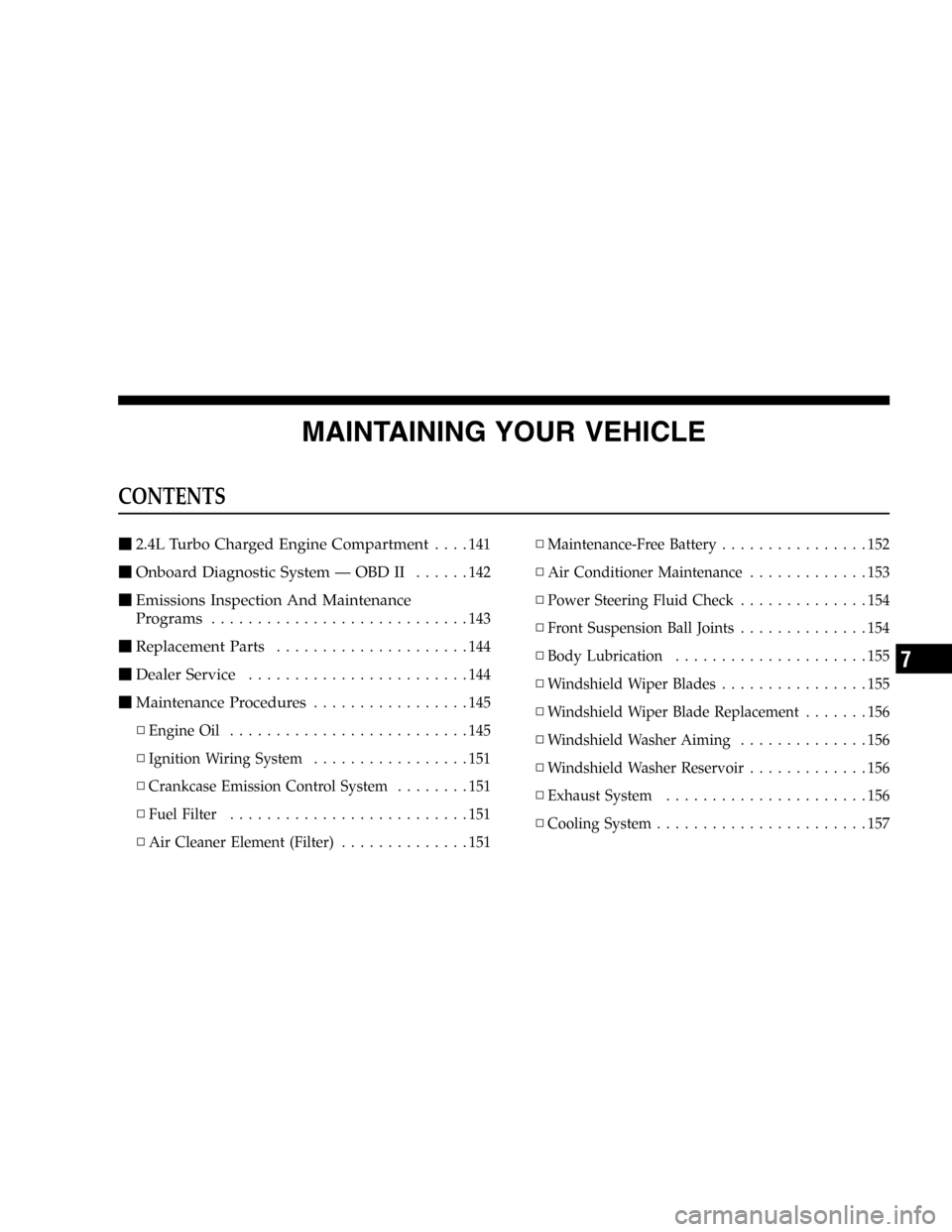
MAINTAINING YOUR VEHICLE
CONTENTS
�2.4L Turbo Charged Engine Compartment....141
�Onboard Diagnostic System—OBD II......142
�Emissions Inspection And Maintenance
Programs
............................143
�Replacement Parts.....................144
�Dealer Service........................144
�Maintenance Procedures.................145
▫Engine Oil..........................145
▫Ignition Wiring System.................151
▫Crankcase Emission Control System........151
▫Fuel Filter..........................151
▫Air Cleaner Element (Filter)..............151▫Maintenance-Free Battery................152
▫Air Conditioner Maintenance.............153
▫Power Steering Fluid Check..............154
▫Front Suspension Ball Joints..............154
▫Body Lubrication.....................155
▫Windshield Wiper Blades................155
▫Windshield Wiper Blade Replacement.......156
▫Windshield Washer Aiming..............156
▫Windshield Washer Reservoir.............156
▫Exhaust System......................156
▫Cooling System.......................157
7
Page 154 of 216
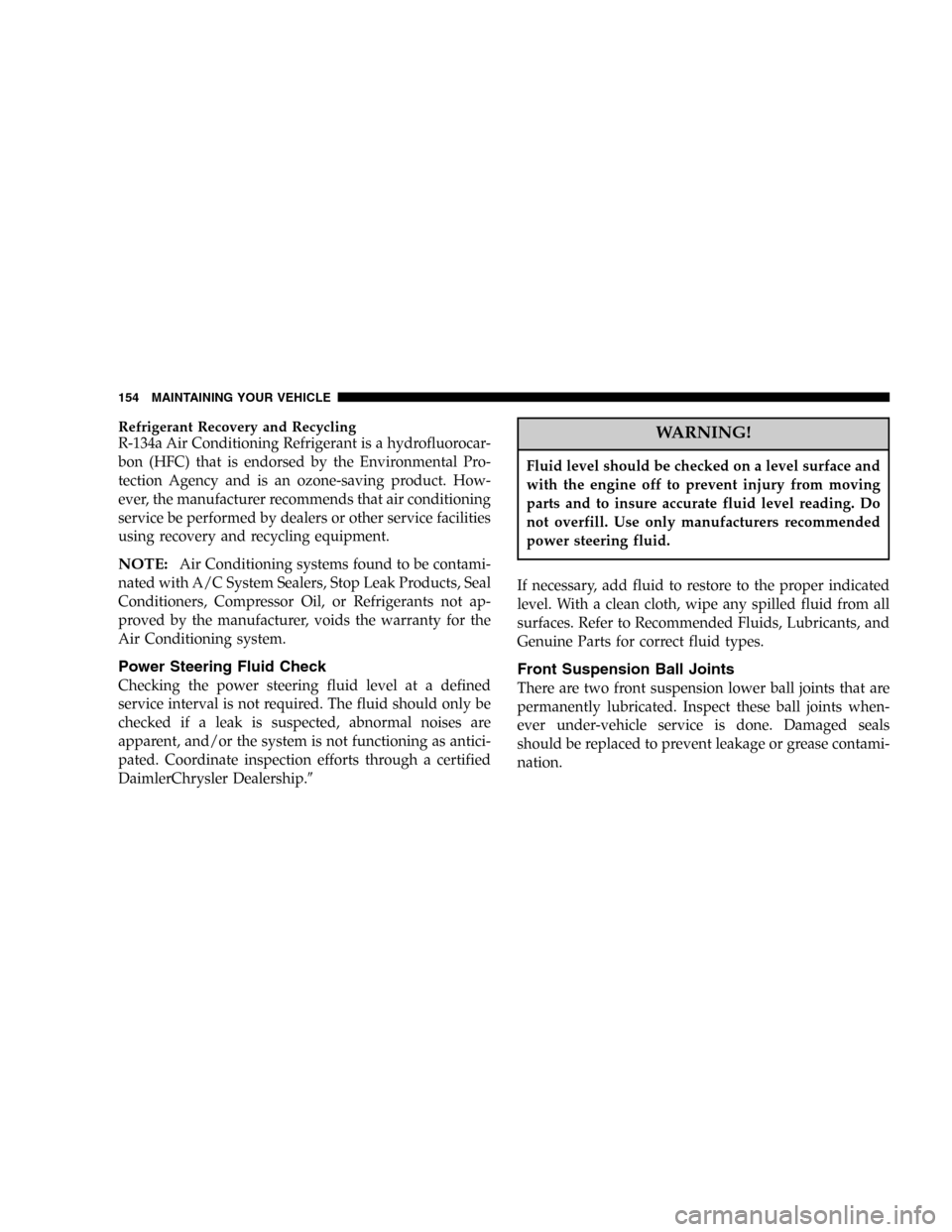
Refrigerant Recovery and Recycling
R-134a Air Conditioning Refrigerant is a hydrofluorocar-
bon (HFC) that is endorsed by the Environmental Pro-
tection Agency and is an ozone-saving product. How-
ever, the manufacturer recommends that air conditioning
service be performed by dealers or other service facilities
using recovery and recycling equipment.
NOTE:Air Conditioning systems found to be contami-
nated with A/C System Sealers, Stop Leak Products, Seal
Conditioners, Compressor Oil, or Refrigerants not ap-
proved by the manufacturer, voids the warranty for the
Air Conditioning system.
Power Steering Fluid Check
Checking the power steering fluid level at a defined
service interval is not required. The fluid should only be
checked if a leak is suspected, abnormal noises are
apparent, and/or the system is not functioning as antici-
pated. Coordinate inspection efforts through a certified
DaimlerChrysler Dealership.�
WARNING!
Fluid level should be checked on a level surface and
with the engine off to prevent injury from moving
parts and to insure accurate fluid level reading. Do
not overfill. Use only manufacturers recommended
power steering fluid.
If necessary, add fluid to restore to the proper indicated
level. With a clean cloth, wipe any spilled fluid from all
surfaces. Refer to Recommended Fluids, Lubricants, and
Genuine Parts for correct fluid types.
Front Suspension Ball Joints
There are two front suspension lower ball joints that are
permanently lubricated. Inspect these ball joints when-
ever under-vehicle service is done. Damaged seals
should be replaced to prevent leakage or grease contami-
nation.
154 MAINTAINING YOUR VEHICLE
Page 162 of 216
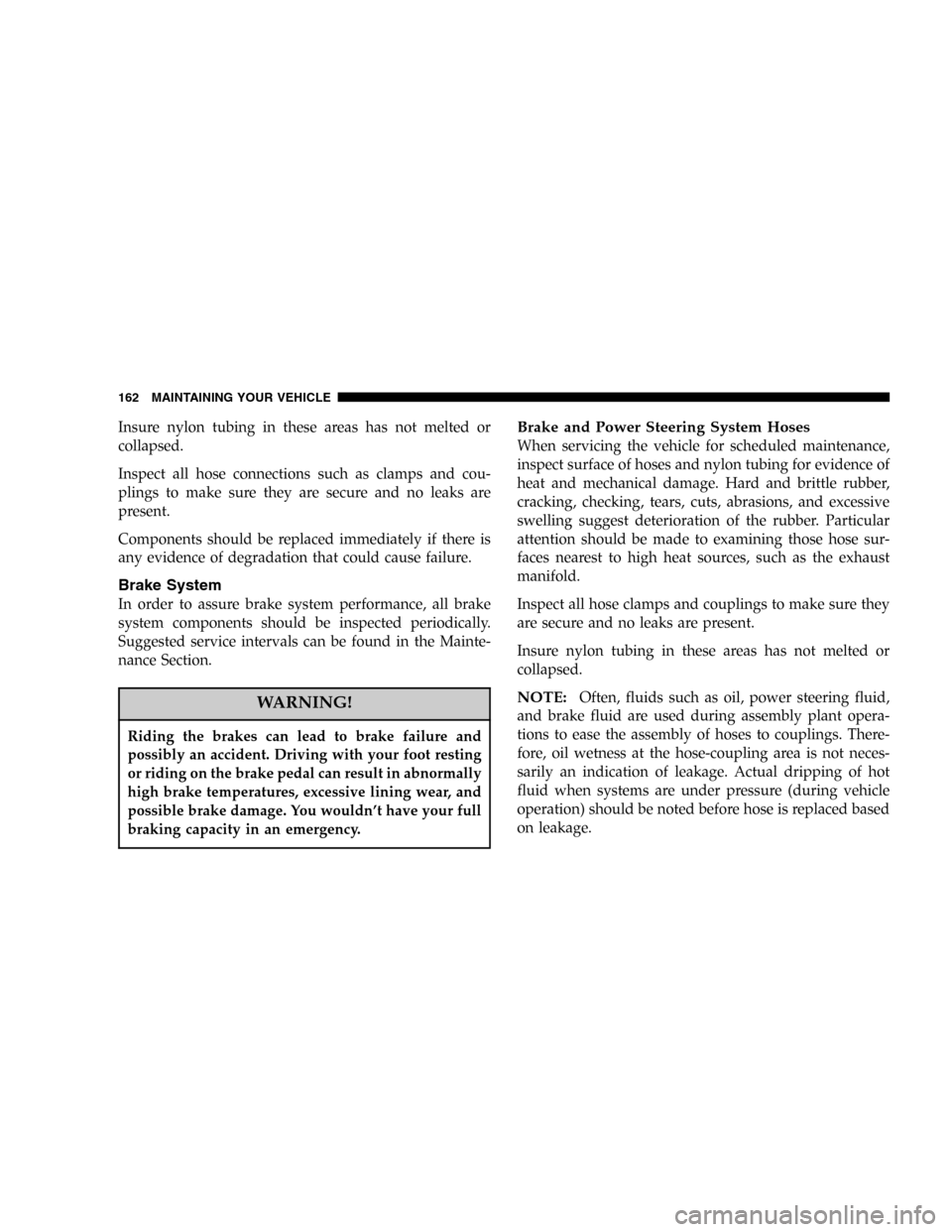
Insure nylon tubing in these areas has not melted or
collapsed.
Inspect all hose connections such as clamps and cou-
plings to make sure they are secure and no leaks are
present.
Components should be replaced immediately if there is
any evidence of degradation that could cause failure.
Brake System
In order to assure brake system performance, all brake
system components should be inspected periodically.
Suggested service intervals can be found in the Mainte-
nance Section.
WARNING!
Riding the brakes can lead to brake failure and
possibly an accident. Driving with your foot resting
or riding on the brake pedal can result in abnormally
high brake temperatures, excessive lining wear, and
possible brake damage. You wouldn’t have your full
braking capacity in an emergency.
Brake and Power Steering System Hoses
When servicing the vehicle for scheduled maintenance,
inspect surface of hoses and nylon tubing for evidence of
heat and mechanical damage. Hard and brittle rubber,
cracking, checking, tears, cuts, abrasions, and excessive
swelling suggest deterioration of the rubber. Particular
attention should be made to examining those hose sur-
faces nearest to high heat sources, such as the exhaust
manifold.
Inspect all hose clamps and couplings to make sure they
are secure and no leaks are present.
Insure nylon tubing in these areas has not melted or
collapsed.
NOTE:Often, fluids such as oil, power steering fluid,
and brake fluid are used during assembly plant opera-
tions to ease the assembly of hoses to couplings. There-
fore, oil wetness at the hose-coupling area is not neces-
sarily an indication of leakage. Actual dripping of hot
fluid when systems are under pressure (during vehicle
operation) should be noted before hose is replaced based
on leakage.
162 MAINTAINING YOUR VEHICLE
Page 177 of 216
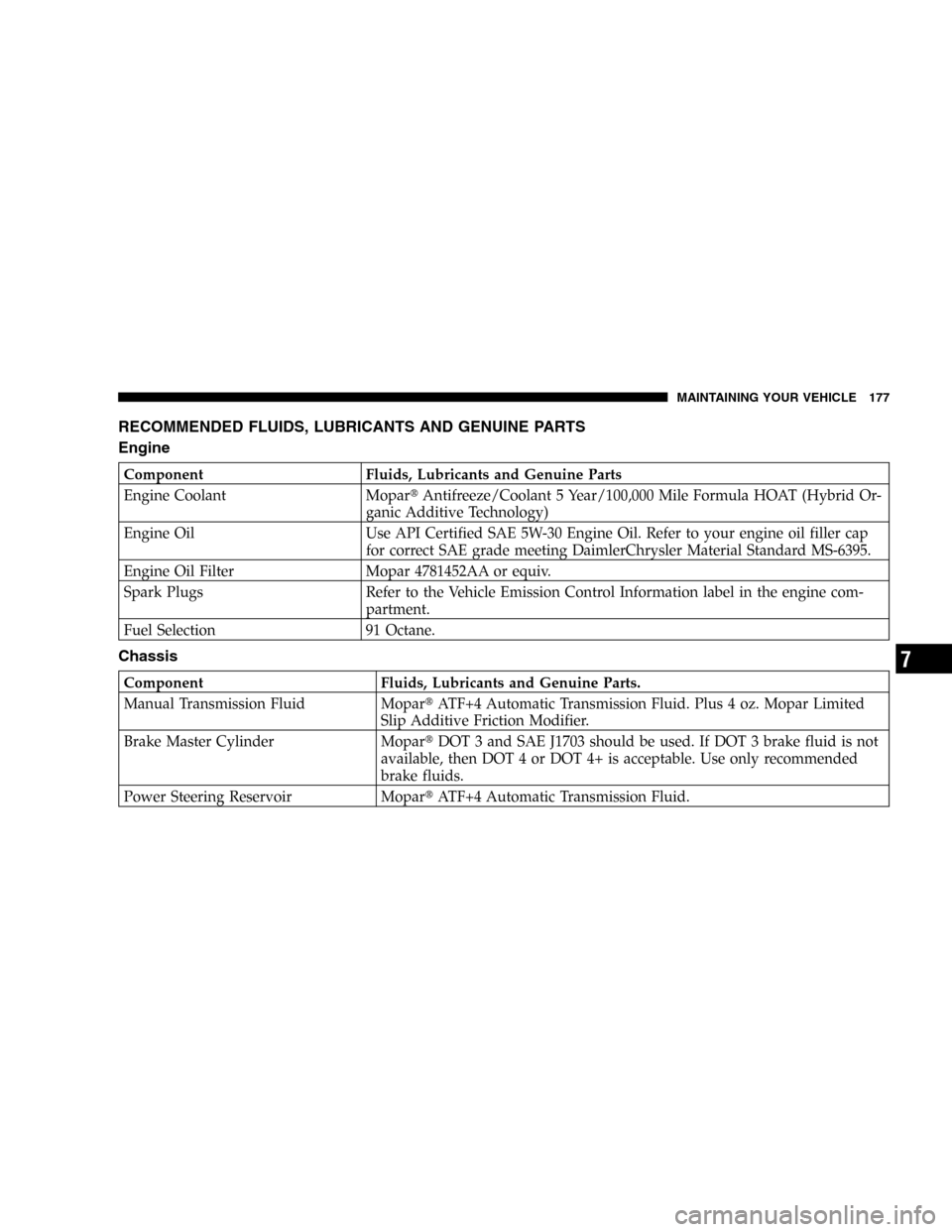
RECOMMENDED FLUIDS, LUBRICANTS AND GENUINE PARTS
Engine
Component Fluids, Lubricants and Genuine Parts
Engine Coolant Mopar�Antifreeze/Coolant 5 Year/100,000 Mile Formula HOAT (Hybrid Or-
ganic Additive Technology)
Engine Oil Use API Certified SAE 5W-30 Engine Oil. Refer to your engine oil filler cap
for correct SAE grade meeting DaimlerChrysler Material Standard MS-6395.
Engine Oil Filter Mopar 4781452AA or equiv.
Spark Plugs Refer to the Vehicle Emission Control Information label in the engine com-
partment.
Fuel Selection 91 Octane.
Chassis
Component Fluids, Lubricants and Genuine Parts.
Manual Transmission Fluid Mopar�ATF+4 Automatic Transmission Fluid. Plus 4 oz. Mopar Limited
Slip Additive Friction Modifier.
Brake Master Cylinder Mopar�DOT 3 and SAE J1703 should be used. If DOT 3 brake fluid is not
available, then DOT 4 or DOT 4+ is acceptable. Use only recommended
brake fluids.
Power Steering Reservoir Mopar�ATF+4 Automatic Transmission Fluid.
MAINTAINING YOUR VEHICLE 177
7
Page 209 of 216

Brake Warning........................ 69
Center Mounted Stop.................. 176
Daytime Running...................... 57
Dimmer Switch, Headlight.............56,57
Dome............................... 55
Exterior Check........................ 46
Fog ................................ 57
Headlights On Reminder................ 57
High Beam Indicator................... 70
Instrument Cluster..................... 56
Interior.............................. 55
Lights On Reminder.................... 57
Malfunction Indicator................... 72
Map Reading......................... 54
Oil Pressure.......................... 70
Park................................ 56
Passing............................. 57
Rear Servicing....................... 176
Rear Tail............................ 176
Seat Belt Reminder..................... 71
Security Alarm........................ 21
Side Marker......................... 175
Theft Alarm.......................... 71Turn Signal.....................57,70,175
Voltage.............................. 71
Warning (Instrument Cluster Description).... 69
Loading Vehicle........................ 125
Tires ............................... 108
Locks................................ 13
Child Protection....................... 16
Door............................... 13
Ignition............................ 143
Power Door.......................... 14
Steering Wheel........................ 13
Lubrication, Body....................... 155
Maintenance.......................... 145
Maintenance, Airbag..................... 37
Maintenance Free Battery................. 152
Maintenance Procedures.................. 145
Maintenance Schedule
Schedule�A�......................... 190
Schedule�B�......................... 183
Maintenance Schedules.................. 180
Maintenance, Sunroof.................... 61
Malfunction Indicator Light.............72,143
INDEX 209
10